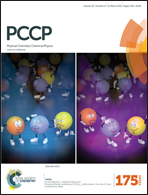The influence of liquid Pb–Bi on the anti-corrosion behavior of Fe3O4: a first-principles study†
Abstract
In this work, the influence of Pb and Bi atoms on the anti-corrosion behavior of the oxide film (Fe3O4) formed on steel surface is investigated based on first-principles calculations. Through calculations of the formation energies, we find that Pb and Bi atoms can promote the formation of point defects, such as interstitial atoms and vacancies in Fe3O4. Besides, the effects of the concentration of Pb (or Bi) and pressure on the formation of these defects are also studied. Our results depict that a high density of Pb (or Bi) and compression pressure can promote the formation of defects in Fe3O4 significantly. Furthermore, the energy barriers for Pb and Bi atom migration in Fe3O4 are also estimated using the climbing image nudge elastic band (CI-NEB) method, which implies that Pb and Bi can diffuse more easily in Fe3O4 compared to Fe. Our results reveal the underlying mechanism of how Pb and Bi influence the anti-corrosion ability of oxide films in an accelerate driven system (ADS). It is instructive for improving the corrosion resistance of the oxide films in the ADS.


 Please wait while we load your content...
Please wait while we load your content...